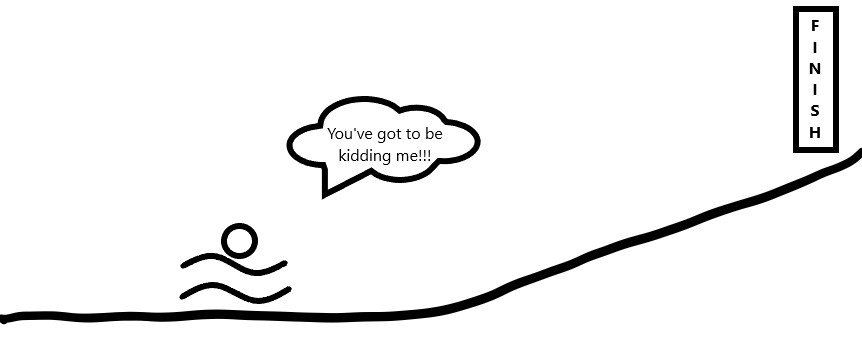
You don’t give up; you fight to the finish.
Louis Zamperini
Visit our shop for cool triathlete merchandise!
Subscribe to receive updates and exclusive content!
When I first got into running, I just enjoyed going for a run. It was before all the smartphones and GPS. Based on a few treadmill runs, I had a general idea of my pace and I would estimate the distance off of that. I avoided workouts I didn’t like.

I hated speed work, too. And strength training? Forget it! It may not have been the wisest approach, but it brought me across the finish line of the Baltimore Marathon, Marine Corps Marathon, Vermont City Marathon and Luray Olympic Distance Triathlon. My performance wasn’t really improving though and the triathlon was pretty miserable. So when I decided to do a half ironman triathlon, I knew I had to change approach. I needed a plan. Since I already knew that I can’t be left to my own devices, I hired a coach. My main fear was that on my own, I will stick to comfortable, enjoyable workouts and not progress as much as I could. I also didn’t want a cookie-cutter plan because those don’t allow for much flexibility of individual variables. My schedule is a bit tricky, so I needed professional advice.
I think when others undertake journeys like mine, they face the same dilemma: should I hire a coach? Or just find a free, pre-made plan?
Making it up as you go on your own
If you aren’t a professional, this is a dubious approach. If you do enough reading, you may be able to patch together some sort of a plan and make it to the finish line, but you won’t rise to your full potential. You are also risking not getting there by missing something important.
Pre-made plan
Pros:
Finding a training plan for your event in a book or online can be a wonderful idea! They are either free or very cheap. If you make sure they come from a good source, they have been tested by hundreds (if not thousands) of people and they work.
Cons:
It’s one size fits all. And that may not be good for you for variety of reasons. For example if you have old injuries, it may not deal with them well. It’s not as bad for running, but when you get into more complex sports, such as triathlon, it may be harder to truly understand each component. Majority of triathletes do strength training. Online plan may only say ‘strength training’ and you may not know what to do. Even worse: not being knowledgeable about weight lifting, you might hurt yourself. The other thing is that pre-made plans don’t allow for curve balls life will throw at you. Can you honestly say that for 12 weeks you won’t get sick, your kids won’t sick or work won’t make you skip a workout?
Online coach
Pros:
I know quite a few people who go this route. It’s definitely cheaper than getting an in-person coach and you get somebody who will actually look at your performance and tailor workouts to your specific needs and abilities.
Cons:
If you have issues with things such as form, an inline coach won’t be of much help. They won’t be there for your weight training, telling you which exercises to do and how to do them.
In-person coach
Pros:
You get a very personalized training plan. There is somebody there for you when you need help with form or to address specific problems. Based on my personal experience, a good coach can help prevent or even fix some injuries.
Cons:
The first obvious con is that having a coach in person tends to be expensive. You may also get somebody who is not great. I have seen enough people with questionable qualifications say that they are personal trainers. This may be risky and they may do more to hurt than help you. Risk of unqualified coach can be mitigated by looking into their background. Keep in mind though: just because they did a sport doesn’t mean they are an expert in coaching somebody in that sport. Last con: you have to work with their schedule. You probably won’t be doing all of your workouts with the coach, but you will need a time for the two of you to meet on a regular basis.
What is the best solution?
Well, it depends. If you are just an average person with an easy schedule, pre-made plan may be all you want. I would suggest actually blending online coach and an in person coach for sport novices and people with difficult life schedule. Online coach will be able to advise what to do when life throws you a curveball or your body doesn’t react to training the way it was expected. I think that in-person coaches are also amazing to help address specific shortcomings. For example, many people struggle with improving their swim. Recurring theme here is poor form. In these cases, a proper swim coach would be the best choice for getting better. However, it’s not a full time commitment. A couple of sessions may be all you need!
When I told my coach that I will be running a marathon in the spring and then 5 months later doing an Ironman, she cringed. My initial thought was: isn’t it a great idea to run the whole distance in training, since you will be beat after swim and bike? So I thought I’d look into it. I will be talking about the triathlon training a lot, but I will address single sport events, too.
Swimming
Open water swimming races are quite an experience… All the crowds around you, the kicking, the sighting, the unpredictable conditions… Believe it or not, but these are factors in how far you have to swim in training.
There isn’t terribly much out there on the subject, but there are a few pieces of advice I saw that I saw in my IM70.3 training plan and it has come up in my open water experiences, as well as those of my friends and family.
First of all: swimming is a low impact sport, so you don’t need to worry about the damage it causes to your body, like you have to with running. This means you can swim as much as you want. You just have to extend the distance carefully (see my post on adding distance here). Your muscle will need a couple of days in between long practices, but it’s nothing like weeks it takes to recover from a marathon.
So now you know it’s ok to swim the distance you will face during the race and you should do it. But that’s not all to keep in mind! Something I thought I was immune to, but I did encounter during my IM70.3:
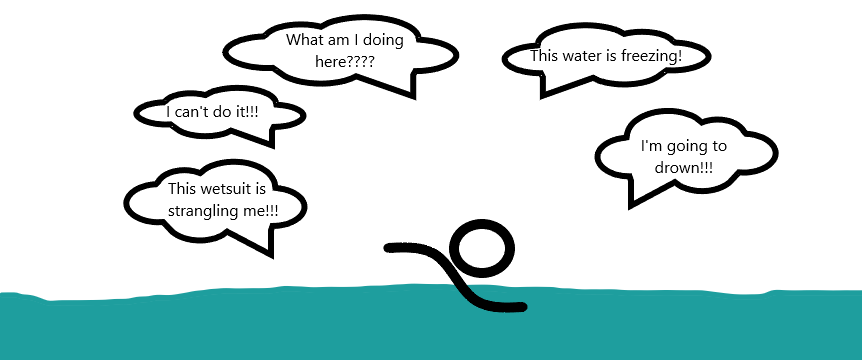
Yes, I’m talking about comfort in the water and panic. It’s more important for you to gain comfort in the water than to work on the distance actually. I am great in the pool, but as it turned out, I am not immune to doubts in the cold sea. You may also have to deal with a wet suit, which is a whole another problem. It’s best to swim as much as you can in one if your race will call for one – your body tires differently in one.
Let’s get back to the actual distance. If you are swimming in the pool, you are always going in a straight line. Do you know why that’s an issue? Because in the open water, you may be dodging other people, fighting currents and struggling to keep a straight line (it’s not as easy when you don’t have the dark line on the bottom of the pool to guide you as you may think).
I know this one is from Halloween, but what if this happens to you when you have problems with sighting:
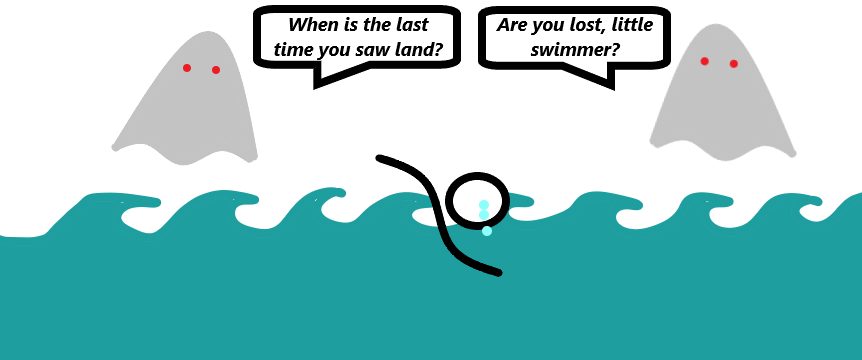
So the actual answer is: a bit more than what the race distance actually is. For a full Ironman, swim portion is 3.8km (2.4 miles). If you are training in a pool, try swimming 4km to get your body used to being in the water that long. Personally, I would recommend doing some extra in the open water, too. You don’t know what obstacles you will be facing on the race day.
Biking
I usually focus on swimming and biking as part of a triathlon, but cycling is a nice sport in its own right with plenty of athletes. There is plenty of people for whom it is their primary focus, so I think it’s a good idea to address endurance training on a bike from both perspective: on its own and as a part of a triathlon. I have used a century ride (100 miles) as a long distance cycling event, since I feel it’s the best approximation of a marathon runners and it’s also the closest common distance to the ride as part of an iron distance triathlon.
Like swimming, biking is also a low-impact sport, so there isn’t as much recovery penalty for distances as there is with running. On the other hand, cycling is the longest part of a triathlon, both distance- and time-wise and it comes with some unique considerations. Most runners and swimmers will assume that the greatest concern is your muscle and endurance when preparing for a long race. However, when it comes to cycling, I have found that it’s actually keeping your butt on the saddle for 6 – 8 hours (or however long it will take you) that hurts a lot. Biking also keeps you in a rather awkward position for hours at a time. In my search for advice on how far should I ride, I saw probably more advice on making sure your back and neck will be ok than on actual distance for your training. I actually already wrote a post on this issue here. So cycling focuses on your body being able to survive the long hours sitting on a bike.
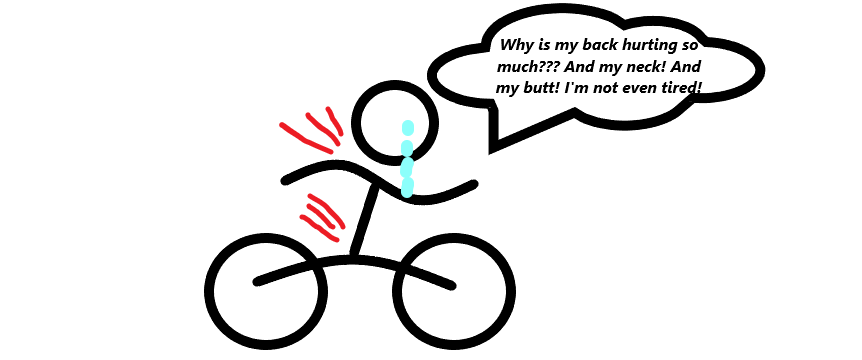
Having said that, recommendations for training distance do exist. For ‘just’ a century ride (a single-sport event), you should complete at least a 70-75 mile ride beforehand. For a 140.6 triathlon, I saw advice going as low as 85 miles. I would call those the bare minimum rides. Since you won’t be dealing with sighting issues like in an open water swim, you don’t need to practice for extra distance, but there is no reason to go the entire 100 miles (for the century ride) or 112 miles (for 140.6 triathlon). I suspect that if your goal is to finish just one century ride, without specific time in mind, you don’t need to hit that distance consistently for a week after week. However, during a triathlon, you will already be ‘pre-fatigued’ (still one of my favorite terms LOL) from swimming and will have to be in good enough shape to make it through a marathon (please note: I am not calling it ‘run’, but 26.2 miles is really far to go on foot). This calls for some level of comfort with the distance. Advice from Beginner Triathlete Blog suggests going 93-112 miles (numbers seem awkward due to unit conversion from the metric system) 10-12 times before the race. This actually seems like a wise piece of advice to me and I think I will be following it. Or at least I will start the 7 hour bike rides on my stationary bike during winter months.
Running
Have you already noticed that the distance you need to complete in training relative to the race distance have been dropping? If so, you won’t be surprised to hear that you run even less when preparing for a marathon.
Marathon and Ironman marathon are their own beasts, so I think it’s a good idea to back up a bit. Majority of people doesn’t plan on running that far. Nevertheless, if you are planning on running in a race/ event, you still need to decide how far to go when training. For your regular 5km and 10km races, it’s easy: just go the distance! It gets more complicated after that though.
When you are planning on racing in a half marathon, there is a couple of questions you need to answer before getting an answer on how far you want to go. The main one, I guess, is if you are going after specific time or do you just want to arrive at the finish line. Because those are two very different events. Based on my various readings over the years and beginning training plans I have seen, you can get away with the longest run of 10 miles. Mind you: it won’t feel awesome and you will be sore afterwards, but you should be able to get your finisher’s medal at the end. I also always think of the 10% rule, which suggests your longest run should be closer to 12 miles. If your plans are more advanced (say: half-marathon under 2 hours), you probably should train a bit more. However, for experienced runners trying to make specific times, I have seen plans going as long as 15 miles.
Off to the big kahuna: the marathon. Here is where we hit the real limitations due to necessary recovery. From my own experience I can tell you that it takes at least a good week to fully recover from 26.2 miles.

Doing this just for training probably isn’t the wisest choice. The one training plan that recommends it is Jeff Galloway. His followers are the groups you will see in the marathon running for a few minutes and then take a walking break. I remember them passing me during the Disney World Marathon. It was a bit funny because they were doing it multiple times. Our average pace was similar, so I would pass them when they were walking and then they would pass me when they would start walking. It was weird! Personally, I am not sold on that method, since I love running at an even pace, but who am I to argue with a professional whose method has worked for many. Jeff Galloway aside, majority of training plans cap at 20 miles. Even ultramarathon training doesn’t seem to advise individual runs much longer than that.
And the key jewel: marathon at the end of an ironman, which is where my inspiration for this post started in the first place. It’s not that easy to find specific advice as to how far is too far to run in training for a long triathlon. I finally found an article on Training Peaks, which said that a triathlete-in-training should do at least 4 runs of 18 miles in preparation for their big day, but limit running training otherwise. I can definitely see how limiting damage to your body done by running would be helpful. After all, you don’t want to slow down your overall progress. They had another piece of useful advice though: work on running right off the bike, so you are prepared for that transition. I guess it’s time for me to start working on those!
I think we all tend to start taking ourselves too seriously sooner or later. Best proof: me freaking out over doing IM70.3. It’s great to be passionate and driven in our pursuits, but I think we need some comic relief every now and then. So here is one 😊
When you decide to train an endurance sport, you are guaranteed to run into animals, some wilder than others. Let’s see…
I do vast majority of swimming in the pool, but during open water swims, I sure have encountered some wildlife. And some I only imagine running into (but I have vivid imagination).
When I was a teenager, I went for a trip to the Maldives and they had an abundance of sharks, albeit tiny ones. They didn’t bother us at all and frankly, I believe they were scared of people. I am yet to meet a large, dangerous shark, but I have heard of triathlons cancelling swim portion due to shark sightings. So if you are ever swimming in the open water, I have a feeling this is what’s going through your head (assuming you can form a coherent sentence):

It’s unlikely that this will happen. Usually people stay away once they are warned about shark sightings. But they are hardly the only marine wildlife making life of a swimmer less fun.
I think that the most common encounters are with jellyfish. I was lucky – the ones in the Baltic Sea I swam past during my Ironman 70.3 are mainly gross to touch, but harmless. I have heard that it’s not so with the ones seen in the US. I am planning on doing Ironman Maryland next fall and I was told that jellyfish can be brutal. Oh, well, I guess I will look like this:

On the other hand, when I was talking to other triathletes, I was told a number of stories about stingrays slapping people during the race:
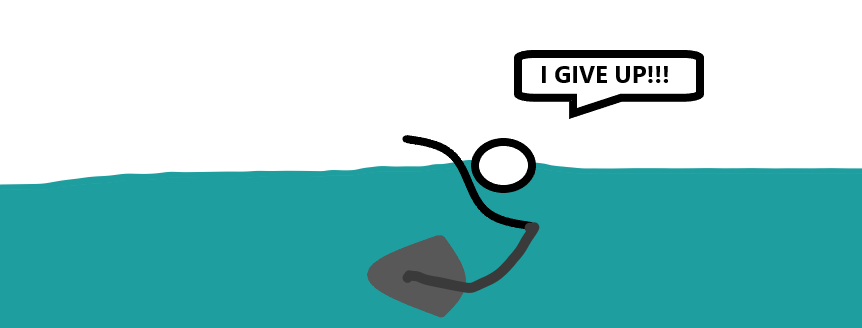
Yeah, somebody mentioned that after a race, they thought that they got kicked by another swimmer until they noticed a huge welt on their leg. Yup! It was a stingray. Of course it’s not like we can even get mad at marine creatures – I suspect they don’t see that many crazy people swimming by.
Fortunately, majority of us won’t ever have to face off against beasts of the open water. And even if we are running that risk, it’s rarely more than once or twice a week during open water swim season. However, we get to meet the animals on the trails on a more/less daily basis. You don’t even have to run or ride to have interesting encounters (although they are so much more ‘fun’ when you’re zooming over 20mph on your bike!).
I think that I most often run into dogs. I know that so far, I have been talking about wild animals. Sadly, some times dogs are the worst behaved critters out there. Well, them and their owners. Just recently, I nearly lost my temper on a guy who didn’t see anything wrong about his dog on a VERY long leash going to the other side of a bike path. It was on a hill, so I was zooming down. I was hitting my breaks yelling for him to pull back the dog. He told me to calm down and wasn’t really pulling his dog back. I seriously considered getting off the bike and slapping him… I am not proud of it, but I suspect that a few people around would have cheered me on.

It’s surprising how many dog owners don’t get this! Then there are these guys:

Maybe not the scariest looking dog… But to me, he’s Cerberus, with eyes glowing red and blood on his fangs. I really don’t care how friendly he is. I have been chased by enough shady dogs that I don’t trust them. I have also been bitten by a dog before. And again: it’s bad enough if you are running, but biking makes it so much worse! No dog approaching you while you’re cycling is safe. They can accidentally knock you over or make you ‘do an ill-advised maneuver’. Oh, and god forbid something happened to the dog. I have a feeling the owner would be yelling at you and demanding that you pay the vet bills.
One of my coworkers actually asked me what my issue is with dogs. I don’t have issue with dogs. It’s their owners that can be a problem. I usually love dogs! I enjoyed saying hello after asking the owner if that’s ok. I’m friends with pretty much every people-friendly dog in the neighborhood (if I’m not, it’s because I haven’t met him/her yet). How about the owner asks if I’m ok with their dog comes over to say hello? If you do it nicely, the chance of me saying yes and playing with your dog is pretty good. But please give me a chance!
Rant finished! Back to wildlife that nobody is in charge of out there, yet let’s stick to chasing and racing. Every now and then, I spook a bunny hanging out in the grass by the road. Their first instinct is to run, except they go in the same direction as me, so it’s kind of like:

At least these guys don’t jump in front of me! In that department, squirrels rule supreme:

I mean: who doesn’t love squirrels in the middle of the road, debating whether to run left or right? They are so cute… And sweet… And for some reason, they just can’t make up their minds! Although, to be fair, I have not hit a squirrel yet or have fallen off a bike because of one. But let’s not jinx it!
At least squirrels try to move out of the way. Not like these jerks:

They just stand there, thinking they are cute! Let’s be honest: tiny squirrel is a lot less dangerous than a deer so accustomed to humans that it won’t move. Or a spooked deer that will try to introduce you to the horns. There is a good reason the saying is ‘deer in the headlight’. I have deer in my bike’s headlight regularly. And guess what? They have forced me to change my path or get off the bike plenty of times. They are just not scared!
So all of these guys are cute and the worst they do is inconvenience you. Somehow, it’s a bird that has caused me the most danger:

Yeah, true story! I learned to wear a hat or a bandanna really fast! I thought that it’s just this one crazy bird by my house, but the other day, I saw on Instagram a post showing cuts on some guy’s head from being attacked by an owl. Knowing this really does happen to people out there, I choose to always cover my head while working out outside.
I am starting to get scary flashbacks, so let’s end with the least scary animal I see all the time:
